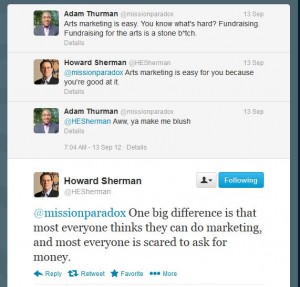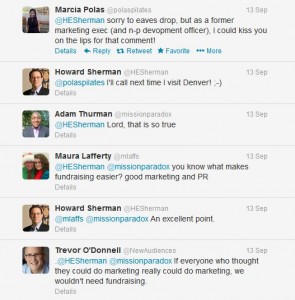Andrew Taylor touches upon a little of what I was thinking about this weekend in his post today. He quotes a recent piece by Marian Godfrey where she talks about how the language used by arts managers and grant makers is alienating and soul sucking.
…like any professional jargon, it puts up barriers and makes people who are unfamiliar with our dialect feel like outsiders, including the very people we are trying to support — artists and engaged people in our communities. I believe we need more humane language to describe ourselves and our visions: words and meanings that are shared by artists, administrators, and the public.
I had been thinking about the specialized language and terminologies used in the arts this weekend. I believe Godfrey was referring to the institutional and general language used to discuss the benefits of the arts as a whole, (I read the whole piece as Andrew Taylor enjoined his readers to do), whereas I was thinking about the terms specific to each arts discipline. As such, I don’t know that I can say I directly disagree with what Godfrey says.
The conclusion I came to this weekend is that while there is quite a bit of vocabulary one must learn in order to comfortably participate in a conversation about a discipline, I don’t think the need to learn a complex set of terms really comprises a significant impediment to becoming an participant or spectator. I think it is just a convenient excuse.
There are plenty of instances where people willingly engage in the time consuming process of learning special terminology. Take MMORPGs like W.O.W. where people will be exposed to terms like: tank, buff/debuff, AoE, aggro, autoloot, cooldown, PvE, PvP, grinding, griefing, among thousands of others. Players are expected to master the terminology, understand the role their character fills and how to use their abilities alongside others to achieve a goal.
Thousands of people happily undertake this challenge every day.
You might argue that people playing online games gain a sense of personal accomplishment that motivates them. But watching sports is often just as passive an activity as watching a performance, (okay, granted you can’t jump up and yell at a ballerina the moment the spirit moves you like you can with an athlete), and requires learning all sorts of arcane rules specific to each game. Often the rules are a little different for each level of play.
People learn these rules and terms because they want to. If they don’t know them, they can seek help from friends or go online to look up the information.
To illustrate this, I intentionally didn’t link to any resource with the gaming terms. Did you look them up or think about looking them up if you didn’t know what they were?
Sometimes this information is collated by the company/team/organization providing the activity. Often these days, people sharing a common interest join together to contribute information to a wiki which exists independently of the organization or activity it covers.
So when people express trepidation about learning the vocabulary and rituals of the performing and visual arts, I think the question really should be why this is so? My impulse is to respond that it is because there are not enough people they are acquainted with either personally or virtually providing a message that it is worth the trouble to learn about it.
I also don’t think there are enough informational resources out there to make it easy for people to learn if they so desire. I just did a Google search for the term “first position” because I can never remember the feet placement for the different positions. I couldn’t find it until I searched for the term “second position.” (Though I did discover A LOT of dance schools are named First Position.)
This is not to say that there aren’t many wikis and specialized dictionaries online which cover arts terminology. American Ballet Theatre has a pretty good dictionary of dance terms. It is just a coincidence that first position doesn’t appear there.
You would have to know to look there though because everyone’s go to source, Wikipedia, only has about 24 terms on it and there isn’t a good dance wiki that I could find. Information sources on theatre terminology are only slightly better.
As much as people say television shows like Glee, Smash and Bunheads don’t reflect reality, they do serve to disseminate the message that singing, theatre and dance are things people should be interested in learning more about.
Like I said, the idea that there isn’t enough of a visible trend and readily available information was something of a primary impression I had. I’d be happy to hear other theories.
While I think some of the terminology and practices might need a change, I do feel fairly strongly that people’s reticence to learn more about arts disciplines can’t be laid primarily at the feet of specialized vocabulary and unfamiliar practices.
People take the necessity of doing this in stride if they are motivated to learn something. Simplifying the language and altering the practices isn’t going to result in a sudden deluge of attendees because the initial motivating impulse will be absent.





There is another way. The Gewandhaus Leipzig in Germany (concert venue) offers flex- tickets for a small premium. Not an…